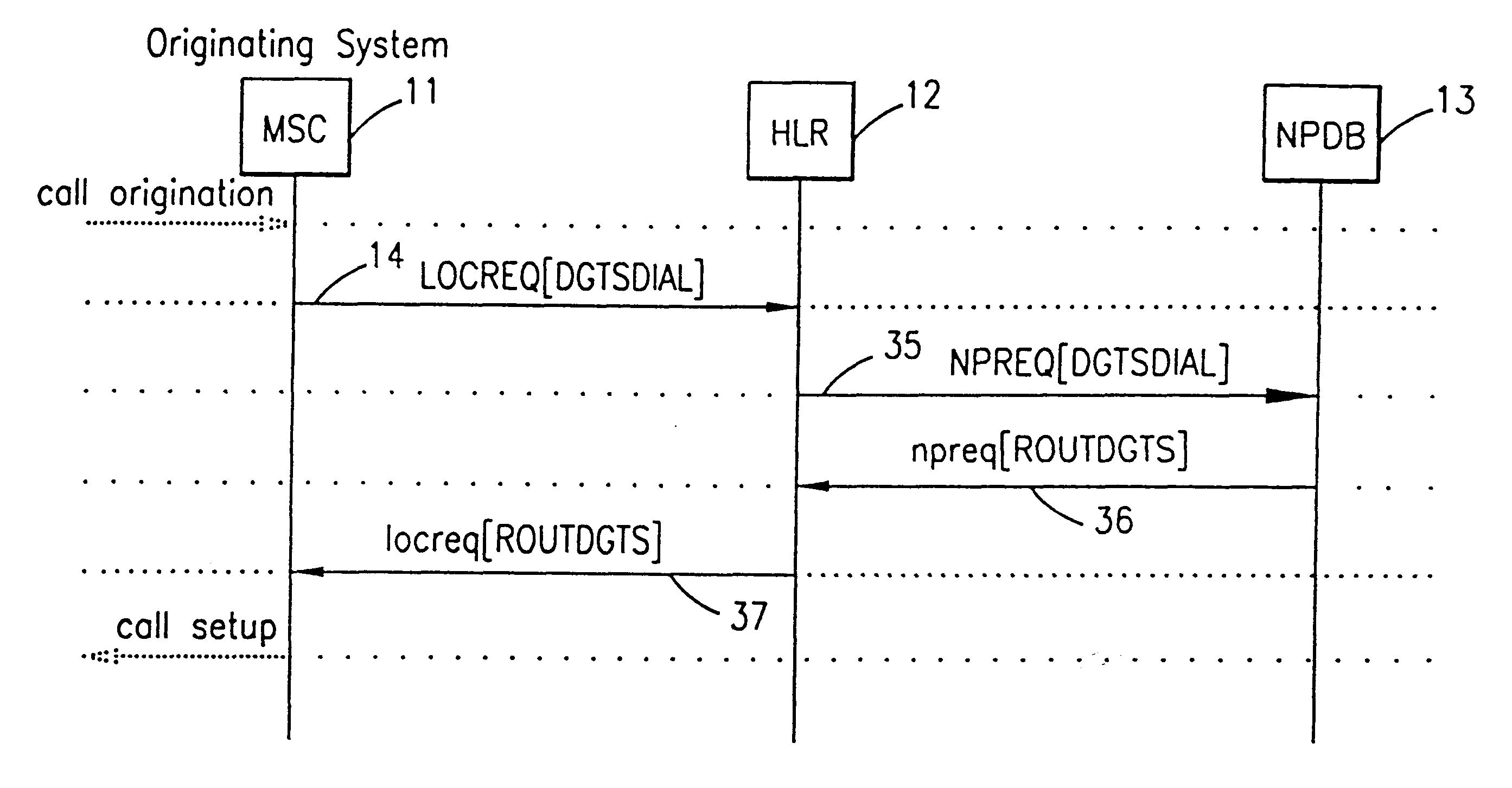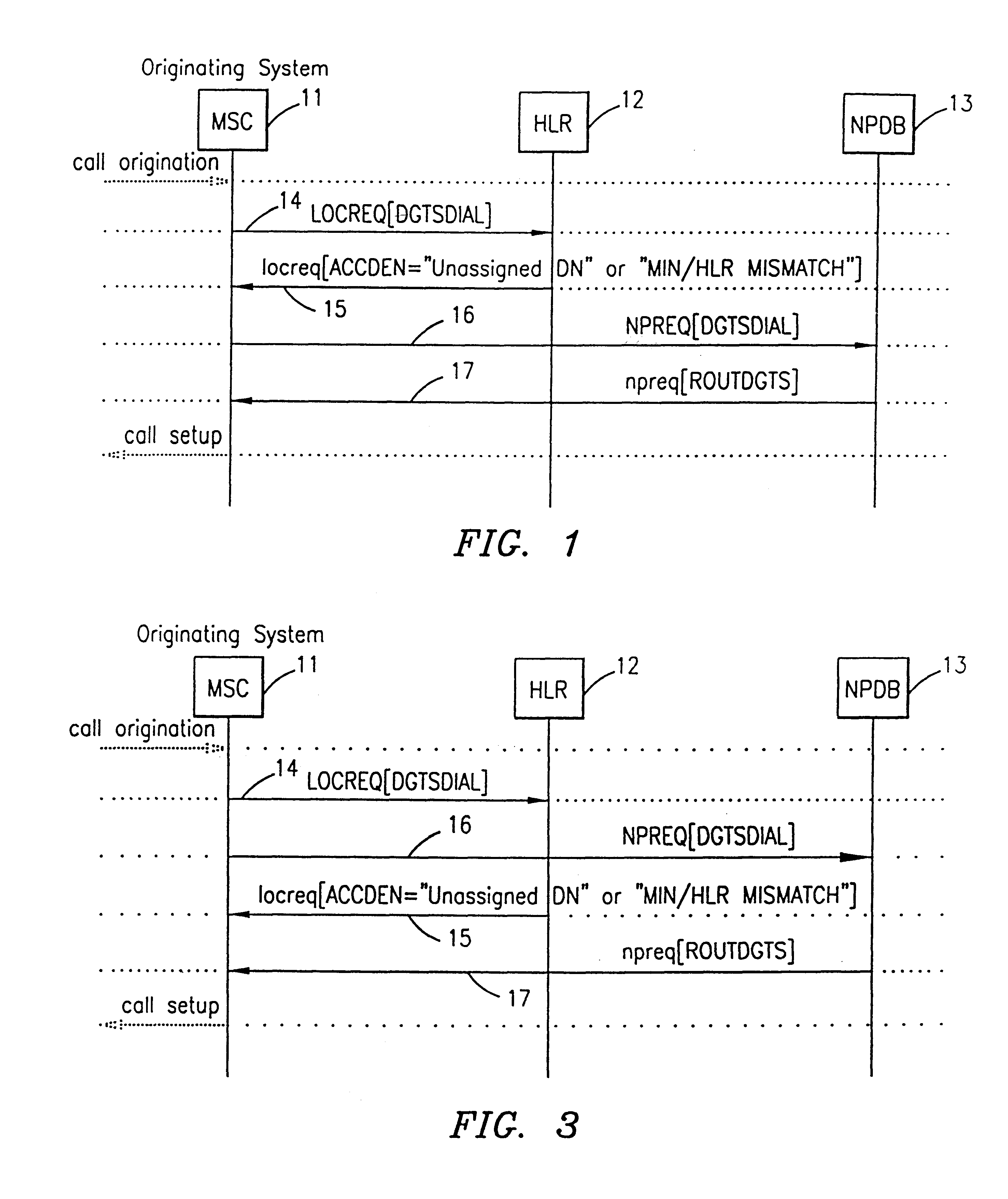Home location register and method of routing calls to portable numbers in a radio telecommunications network
a radio telecommunications network and home location technology, applied in the field of telecommunication systems, can solve the problems of no process by which the msc may give priority to one of the two queries (locreq or npreq), and cannot salvage a call
- Summary
- Abstract
- Description
- Claims
- Application Information
AI Technical Summary
Problems solved by technology
Method used
Image
Examples
first embodiment
FIG. 1 is a message flow diagram illustrating the flow of messages between the nodes of a radio telecommunications network in the present invention. The network includes an originating MSC 11, a home location register (HLR) 12, and a Number Portability Database (NPDB) 13. The originating MSC may be a gateway mobile switching center (G-MSC) where a call enters the Public Land Mobile Network (PLMN) from another network such as the Public Switched Telephone Network (PSTN), or it may be an originating mobile switching center (O-MSC) where a call originates within the PLMN.
For calls originating in the O-MSC 11 (or arriving at a G-MSC) without an indication that a NP query has been performed, the O-MSC determines whether it "owns" the dialed DN, and if so, first attempts to route the call normally by sending a Location Request Invoke message (LOQCREQ) 14 to the HLR 12. However, the DN ownership determination may be incorrect because in mobile networks, the DN ownership is actually determi...
second embodiment
FIG. 3 is a message flow diagram illustrating the flow of messages between the nodes of a radio telecommunications network in the present invention. In this embodiment, the O-MSC 11 simultaneously sends a LOCREQ message 14 to the HLR 12 and a NPREQ message 16 to the NPDB 13. The O-MSC then acts on the first response which includes a routing number. For example, if the locreq message 15 is received first, and includes an Access Denied parameter indicating that the DN is unassigned, then the O-MSC waits for the npreq message 17 with a LRN. Alternatively, if the npreq message is received first, and it does not contain a LRN, or if the response is otherwise useless (for example, the npreq message contains an LRN associated with the O-MSC), then the O-MSC waits for the locreq message to return a routing number. If the first response received includes a routing number, the call is routed without waiting for the second response. If both return result messages return errors, then an error h...
third embodiment
FIG. 4 is a message flow diagram illustrating the flow of messages between the nodes of a radio telecommunications network in the present invention. The O-MSC first attempts to route the call normally by sending a LOCREQ message 14 to the HLR 12. In this embodiment, the HLR is modified to send a NPREQ message 35 to the NPDB 13 when the HLR does not have a subscription for the DN identified in the DGTSDIAL parameter of the LOCREQ message, and the DN is in a portable number series. The NPDB then returns the LRN in npreq message 36 sent to the HLR. The HLR, in turn, includes the LRN in a locreq message 37 sent to the O-MSC. The O-MSC then completes the call setup to the LRN.
PUM
 Login to View More
Login to View More Abstract
Description
Claims
Application Information
 Login to View More
Login to View More - R&D
- Intellectual Property
- Life Sciences
- Materials
- Tech Scout
- Unparalleled Data Quality
- Higher Quality Content
- 60% Fewer Hallucinations
Browse by: Latest US Patents, China's latest patents, Technical Efficacy Thesaurus, Application Domain, Technology Topic, Popular Technical Reports.
© 2025 PatSnap. All rights reserved.Legal|Privacy policy|Modern Slavery Act Transparency Statement|Sitemap|About US| Contact US: help@patsnap.com



